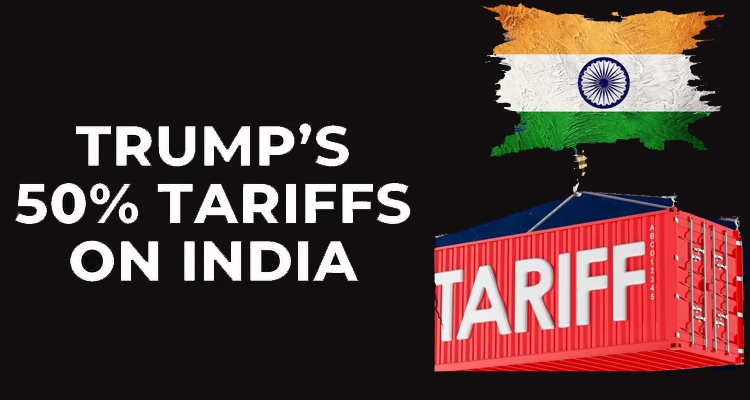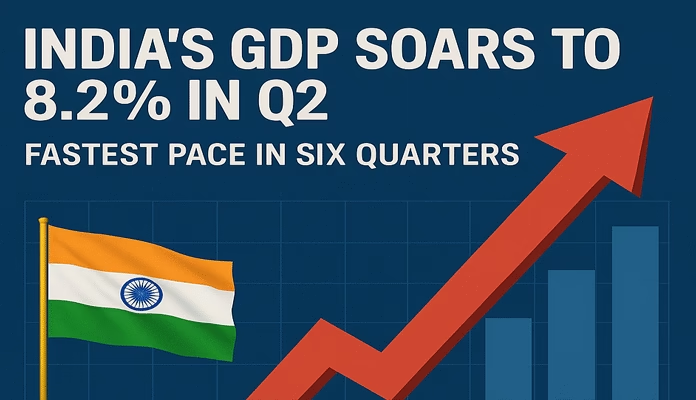India’s Big Reboot: How 50% U.S. Tariffs Could Trigger Reforms
 A Shock That Can Reshape India’s Future
A Shock That Can Reshape India’s Future
The announcement from Washington landed like a thunderclap. With one stroke of the pen, former U.S. President Donald Trump raised tariffs on a wide range of Indian goods to a punishing 50%, instantly rattling exporters, investors, and policymakers alike. For many, this move looked like an economic ambush—threatening jobs, markets, and a trade relationship worth billions.
But dig deeper, and a different story emerges. Behind the immediate pain lies a rare opportunity—one that could push India to break free from its old dependencies, reset its trade compass, and trigger the long-discussed but often delayed reforms. Far from being a mere setback, this tariff shock could become the very catalyst for India’s long-overdue economic reboot.
The Blow: India’s Export Engine Takes a Hit
The sectors most exposed—textiles, gems and jewellery, leather, seafood, and handicrafts—have long been India’s pride and livelihood generators. Together, they employ millions, especially in small towns and clusters from Tirupur to Surat. A 50% tariff effectively prices many of these products out of the American market, where cost sensitivity is razor-sharp.
Exporters fear cancelled orders, shrinking margins, and layoffs. For a country still navigating post-pandemic recovery, the risks to employment are serious. Short-term turbulence is inevitable, and the impact will be felt most in labour-intensive industries that form the backbone of India’s export basket.
The Hidden Silver Lining
Yet crises have a peculiar way of forcing difficult choices. India has long depended excessively on a handful of markets, particularly the U.S., for bulk exports. That comfort zone has now been disrupted. The tariffs, however harsh, present a chance to push India toward:
-
Diversification of Markets — Expanding aggressively into Europe, Latin America, Africa, and ASEAN to reduce over-reliance on a single buyer.
-
Moving Up the Value Chain — From being a low-cost supplier to becoming a producer of branded, high-quality, innovative products.
-
Boosting Domestic Demand — Using fiscal levers, GST tweaks, and credit support to encourage Indians to buy Indian-made products, ensuring industries have a fallback market.
-
Accelerating Reforms — Simplifying tax structures, cutting red tape, and investing in infrastructure that reduces logistics costs and improves global competitiveness.
India at a Crossroads
This isn’t the first time global shocks have tested India. In the early 1990s, a balance-of-payments crisis forced sweeping liberalisation that reshaped the economy for decades. In 2008, the global financial crisis prompted banks and regulators to strengthen buffers. Today, the Trump tariffs offer a similar inflection point—painful in the short run, but potentially transformative in the long term.
If India seizes this moment with courage, it can position itself as a trusted alternative in global supply chains. With the West wary of overdependence on China, the timing for India’s rise couldn’t be more strategic.
The Policy Response: From Firefighting to Future-Building
In the immediate term, the government must cushion exporters with credit guarantees, duty rebates, and liquidity support to avoid mass closures. But the larger game plan must look beyond temporary relief.
-
Structural Overhaul: GST simplification, labour-law rationalisation, and single-window clearances to cut costs and delays.
-
Industrial Upgradation: Incentives for modernisation, design innovation, and branding in traditional sectors.
-
Export Blitz: Aggressive trade diplomacy to open new markets and strike preferential trade agreements.
-
Self-Reliance with Scale: “Made in India” should move from slogan to reality, not by closing doors but by building world-class competitiveness.
The Business Playbook
Indian companies, too, must adapt boldly. Instead of waiting for subsidies, businesses should:
-
Diversify supply chains and customer bases.
-
Invest in design, technology, and brand-building.
-
Explore joint ventures and assembly bases in tariff-neutral countries.
-
Embrace sustainability and compliance as selling points in global markets.
A Setback That Could Become a Springboard
Trump’s tariff shock is undeniably disruptive. Factories will feel the heat, exporters will scramble, and livelihoods may face stress in the short term. But this is not the end of India’s trade story—it could be the beginning of a new chapter.
The choice is stark: treat the tariffs as a crippling blow or embrace them as a wake-up call. If India chooses the latter, it could transform vulnerability into strength, dependency into self-reliance, and low-cost exports into high-value global brands.
In the final analysis, this tariff storm may not be a setback at all. It might just be the golden chance for India’s big reboot.




